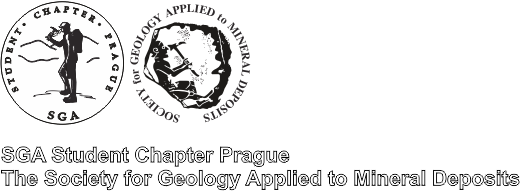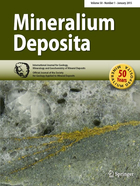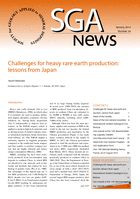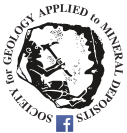Jakub Ptáček1,2, Jan Mráček1,2
1Faculty of Science, Charles University, Prague, Czech Republic
2Czech Geological Survey, Prague, Czech Republic
SGA Student Chapter Prague organized its 2024 autumn field trip to selected geological sites in the Western Bohemia. From October 25 to 28, 2024, a total of 25 members participated in the excursion.
1st day
The first stop of our field trip was the Příbram mining district, located in Central Bohemia. This district is one of the largest uranium-polymetallic hydrothermal vein-type deposits in the world (Pauliš et al. 2016). The veins in this district were formed during the Variscan orogenesis, with the vein system extending over an area of approximately 25 x 2 km at the boundary between the Teplá-Barrandian Unit (TBU) and the Moldanubian Zone. The veins are hosted in Neoproterozoic to Lower Paleozoic sedimentary or volcano-sedimentary rocks of the TBU, in close exocontact with the Upper Devonian to Carboniferous granodiorites of the Central Bohemian Plutonic Complex, separating TBU and the Moldanubian Zone of the Bohemian Massif (Černoch et al. 1995; Janoušek et al. 2010; Pauliš et al. 2016). On numerous tailing heaps, it is possible to collect primarily calcite vein material, occasionally accompanied by sphalerite, hematite, galena, and, more rarely, radioactive uraninite.
Our next stop was a historical underground kaolin mine in Nevřeň. The site features extensive hand-dug spaces, with halls reaching up to 12 meters in height and 8 meters in width, carved into Carboniferous arkosic sandstones and arkoses. The elevated kaolinite content in these sediments resulted from the weathering of nearby feldspar-rich plutonic bodies. Kaolinite remains one of the most significant natural resources in Western Bohemia.
The third stop of our journey was the Pb-Zn-Ag polymetallic deposit of the Stříbro mining district. Mining in Stříbro began in the 12th century. The village was given the name Stříbro which translates to English as “Silver“ because silver ore was found right under the surface. Unfortunately, the silver mineralization was present only at the uppermost part of the deposit. Upon our arrival, we visited a locality directly above the historical mine to collect samples with pyromorphite, which is a supergene mineral of Pb ore. Continuing our exploration of the deposit, we arrived at a nearby spoil heap close to the village of Sytno, where we found numerous quartz crystals, galena, and occasionally sphalerite. We concluded our visit to the Stříbro mining district with a guided tour of the historic Prokop adit (Fig. 1), located right in the town of Stříbro. Most common minerals include galena and sphalerite and in smaller amounts pyrite, marcasite, and chalcopyrite.
To conclude the first day, we visited Vlčí Hora hill near Černošín to collect crystals of amphibole (kaersutite) and pyroxene (augite). Vlčí Hora is a Neogene volcano formed as part of Cenozoic Central European Volcanic Province (CEVP), estimated to be approximately 12 million years old. It is located on the northwestern edge of the TBU, emplaced within the chlorite-sericite phyllites of the Proterozoic Blovice Accretionary Complex (Pauliš 2000; Navrátil and Šrein 1997). Well-formed crystals of kaersutite and augite weather out of the pyroclastics from this volcano. These crystals can reach lengths of over 5 cm, making this site highly sought after by local collectors.
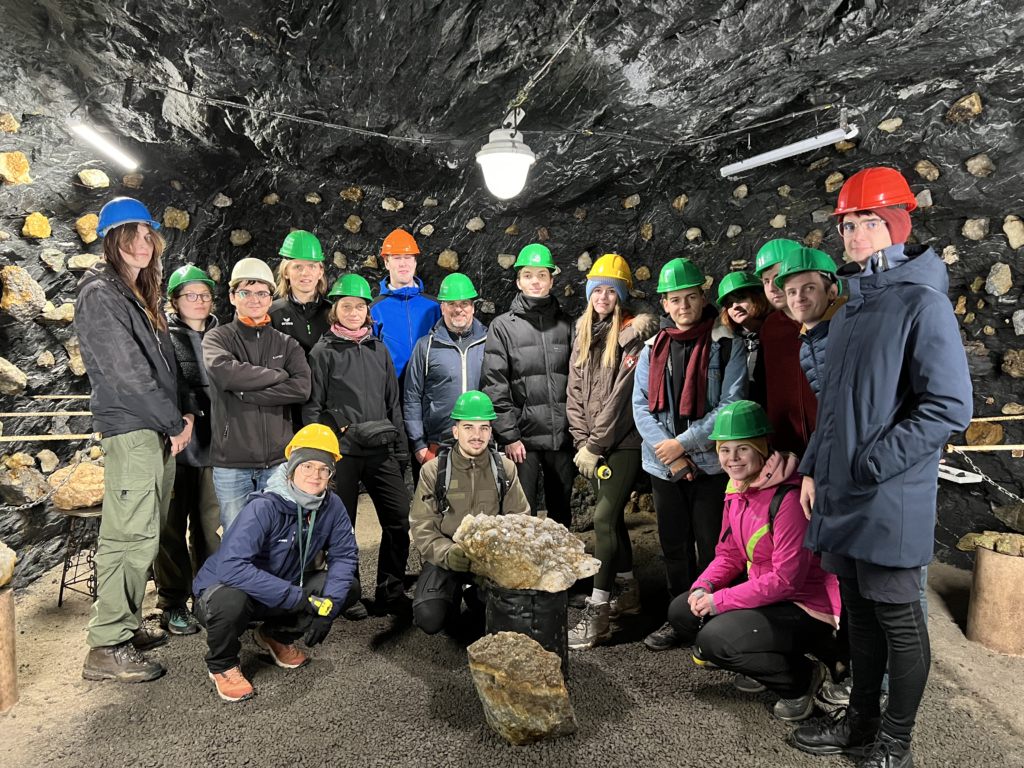
2nd day
The second day of the trip focused on the mining district of Michalovy Hory, located in the western part of the Teplá-Barrandian area. This region is primarily composed of Proterozoic metamorphic volcano-sedimentary rocks, including gneisses, amphibolites, and crystalline limestones. A distinctive feature of Michalovy Hory is the occurrence of supergene minerals, which form primarily through the weathering of common sulfides in the supergene zone. During our visit, we explored three locations: Dolní Kramolín (Ag-Pb-Zn polymetallic mineralization), Michalovy Hory (Ni ores), Chodová Planá (Cu-Pb-Zn mineralization).
The highlight of the second day was a nighttime collection of secondary uranium minerals using a UV light at Kladská (Fig. 2), one of the many geologically fascinating localities in the Slavkovský Les area. The Slavkovský Les lies on the boundary between the Saxothuringian Zone and TBU. Kladská, located in the western part of the Slavkovský Les, was historically mined for tin ore in greisen-type deposits. Today, it is well known for its uranium mineralization, primarily represented by uranium micas and various stages of altered uraninite (Plášil et al. 2016).
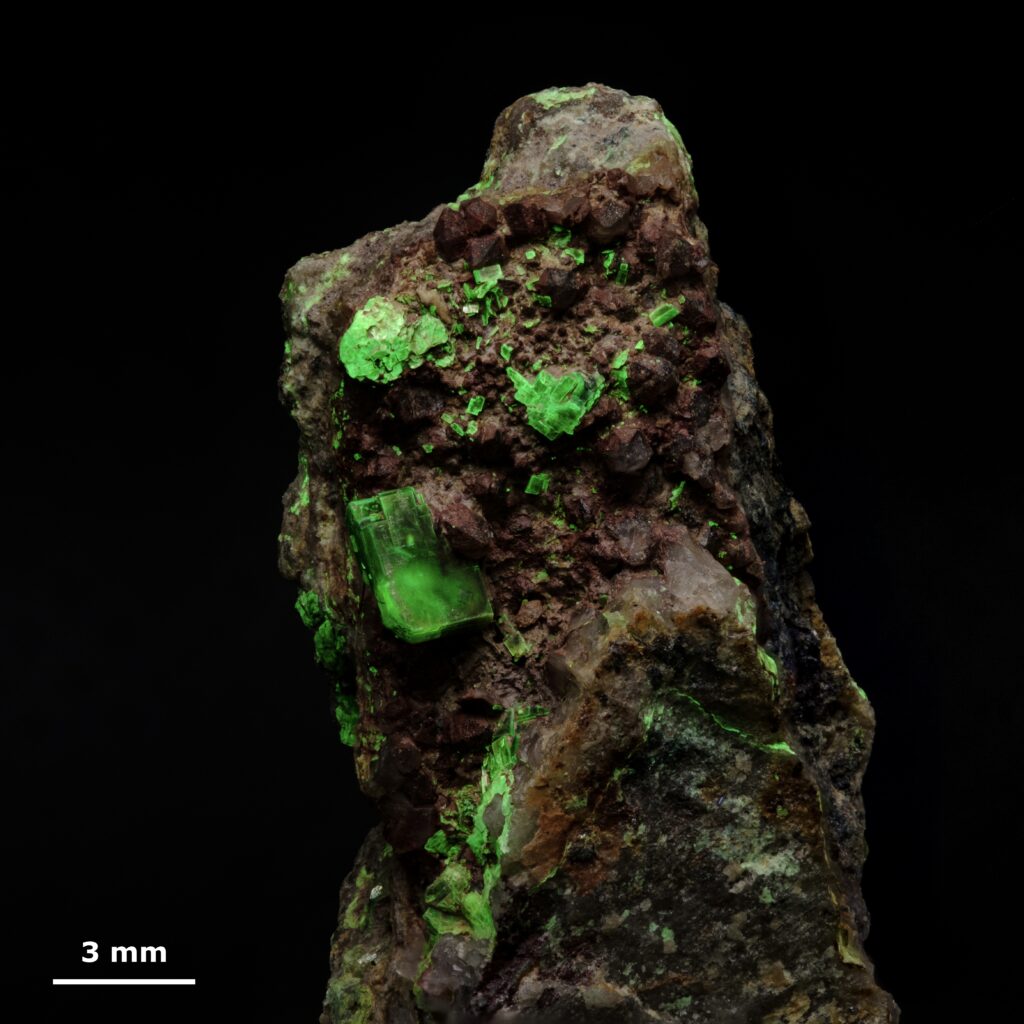
3rd day
The first stop of the third day was the National Natural Monument Křížky, part of the Mnichovské hadce — the largest uncovered serpentinite body in the Czech Republic. This geological formation appears in a belt that stretches about 9 km in length and 2 km in width. In addition to the fascinating geology, we also explored the connection between different science fields. At this site, the influence of the serpentinite on the composition of the derived soils is clearly evident, as seen in the subsequent occurrence of endemic plants (e.g. Cerastium alsinifolium). These plants thrive in soils characteristic of serpentinite bedrock, which are rich in magnesium but deficient in essential nutrients (N, P, K).
The second stop of the day was the National Nature Reserve Soos, located in the center of the Cheb Basin. This site is a beautiful example of post-volcanic activity, where the movement of Tertiary tectonic faults opened a pull-apart basin with developing peat bogs and several mineral springs, highly enriched in CO2 (Fig. 3). The carbon dioxide can be also released from the water underground, accumulate within the layers of Tertiary sediments and rise to the surface through fractures, forming mofettes.
After a walk through the peat bog, the excursion continued north of Hazlov to the day’s next site, known as “U Cihelny.” In this small area in the westernmost part of the Czech Republic, contact metasomatic calcareous-silicate rocks called erlan are well exposed. The mineral vesuvian is fairly abundant here, alongside with other typical erlan minerals, such as diopside, grossular, anorthite, and quartz.
The final stop of the day was the radioactive spring Břetislav – Radonka, located in the Skalná – Bad Brambach area. In this area, there are 117 springs with elevated radon content (222Rn). Of these, 48 springs exhibited activity levels exceeding 1,500 Bq/l, the threshold in the Czech Republic for classifying water as mineral water. The Břetislav – Radonka spring is the most radioactive surface outflow in the Czech Republic, with activity levels ranging from 11,431 to 13,138 Bq/l and a flow rate of 2.5 l/min. Apart from its delicious taste, this spring is considered to be beneficial for your health.
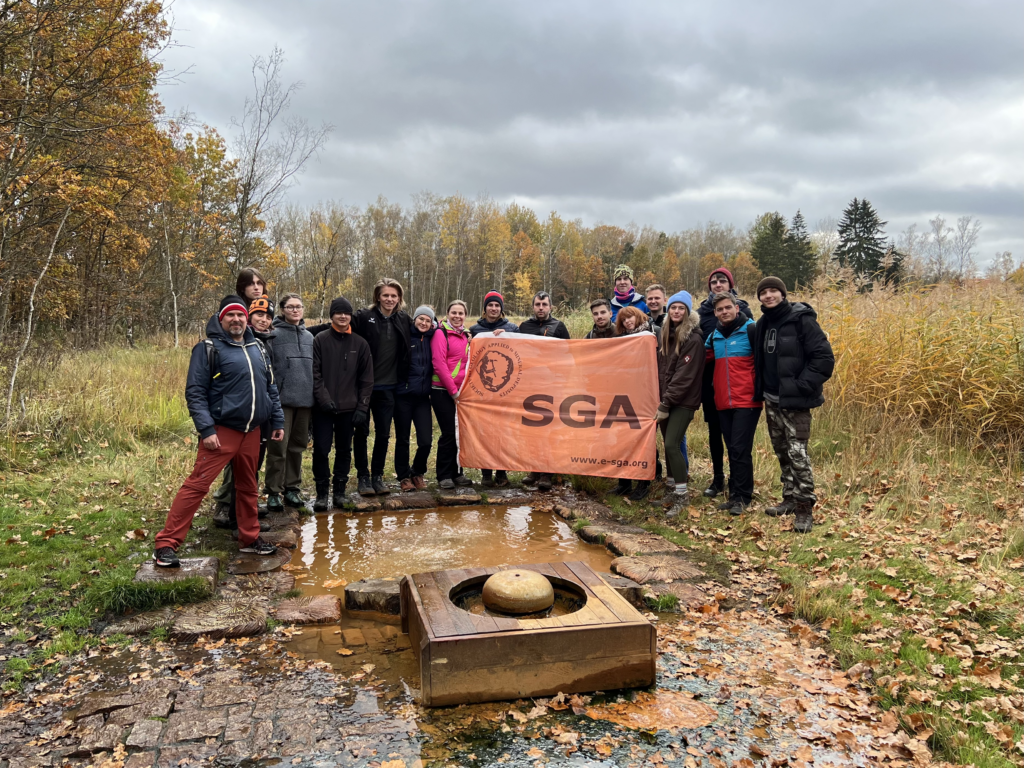
4th day
The final day began with a visit to the Silvestr lignite mine, situated on the southern edge of the Sokolov Basin. Mining began here in 1939 as a small-scale operation. The lignite was extracted from the Antonín and Anežka seams, which reached thicknesses of up to 65 meters. With an overburden of only 10 meters, the site offered highly favorable conditions for mining development. In 1953, significant investments transformed the operation into a large open-pit mine. By 1955, annual lignite production exceeded 1 million tons, peaking in 1971 at 4.153 million tons. Mining ceased in 1981, with a total output of 90 mega tons of lignite and roughly 50 million m3 of overburden extracted. As the recultivation was only carried out in part of the Silvestr mine, the visited southern unrecultivated slope, represents a unique example of an open-pit mine “taken back by nature”. Here, the mine slope is dissected by a network of erosion gullies, rill washes, and erosion ravines, separated by ridges and pyramids, resembling the “Badlands” of the American West. This location provides an exceptionally instructive and active site for studying erosion processes, accumulation, and the impact of vegetation cover on geological processes. Despite (or perhaps because of) the absence of recultivation, this area has become a habitat for protected species and a nesting site for the sand martin (Riparia riparia) birds (Rojík 2008). Through the decision not to recultivate the site, a unique record of the cyclic wildfires of Miocene rainforests has been preserved. Rojík (2008) documented 57 trees in this location and interpreted it as a forest burning approximately 22 million years ago. The charred remnants of the forest are manifested by the presence of fusain, which is often mineralized by SiO2 modifications.
After visiting the lignite mine, the group traveled to Karlovy Vary to explore its world-famous spa springs. The highlight of this stop was an excursion to the technical utility room of Vřídlo, the largest thermal spring in Karlovy Vary. Vřídlo emerges at a temperature of 73°C and, due to the high pressure of CO2 gas, reaches a stable height of up to 12 meters. The spring has a flow rate of up to 2,000 l/min, and with a mineralization of up to 6.45 g/l the intake pipes in the complex need to be replaced frequently. While this location was not a collecting site, every participant took home a piece of aragonite pipe infill, a form of aragonite commonly known in the Czech Republic as vřídlovec.
The very last location of the entire excursion was a visit to the Doupovské Hory mountains and the famous mineralogical location of Valeč, well-known for findings of glassy opal – hyalite (Fig. 4). Valeč is situated on the southeastern slopes of the Doupovské Hory volcanic complex, formed as the NE branch of the CEVP. The lower part of this volcanic complex is the most exposed part and primarily formed by pyroclastics. At this site, coarse-grained slags from a local pyroclastic cone are overlain by a lava flow. At the interface between these layers, dissolved quartz material precipitated within fissures and vesicles, forming the glassy opals. The most striking specimens are crown-like aggregates, reaching sizes of up to 7 cm. Some of the hyalites can also be covered with white layers of staffelite.
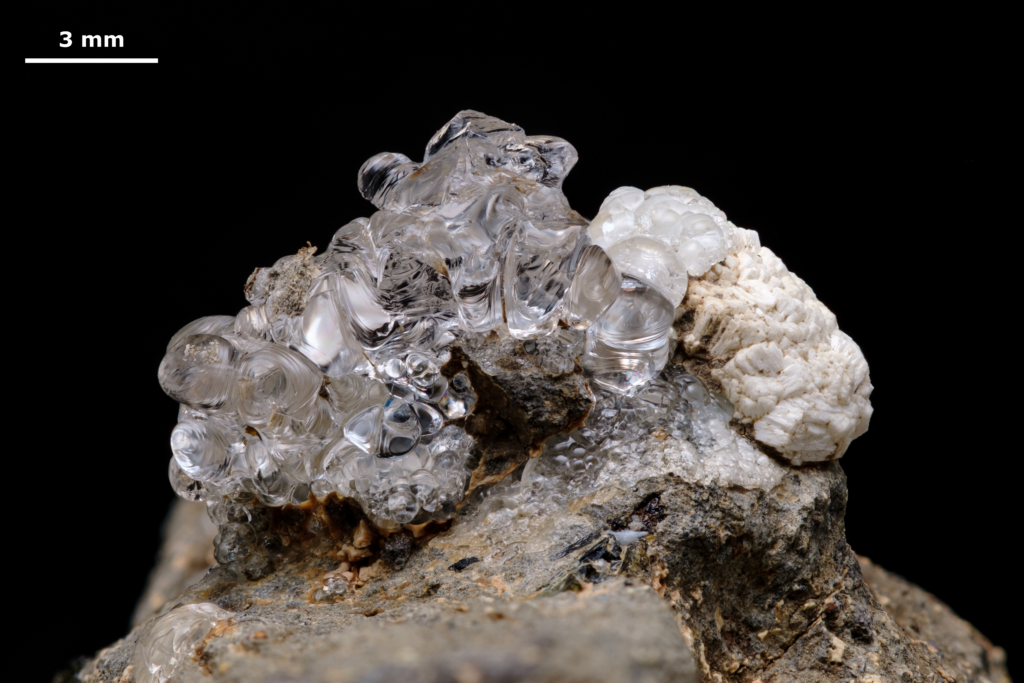
References:
Černoch V, Staněk V, Škvor K (1995) Závěrečná zpráva ložiska Příbram. Diamo, s.p., SUL o.z., Příbram, 172 pp
Janoušek V, Wiegand BA, Žák J (2010) Dating the Variscan crustal exhumation in the core of Bohemian Massif: new U-Pb single zircon ages from the high-K calc-alkaline granodiorites of the Blatná suite, Central Bohemian Plutonic Complex. J Geol Soc London 167:347–360
Navrátil Z, Šrein V (1997) Krystalovaný olivín v tufech Vlčí hory u Černošína. Bull mineral-petrolog Odd Nár Muz (Praha) 4–5:177–178
Pauliš P (2000) Nejzajímavější mineralogická naleziště Čech. Kuttna, Kutná Hora, 112 pp
Pauliš P, Babka K, Sejkora J, Škácha P (2016) Uranové minerály České republiky a jejich nejvýznamnější naleziště. Kuttna, Kutná Hora, 557 pp
Plášil J, Sejkora J, Čejka J, Pavlíček R, Babka K, Škoda R (2016) Výskyt boltwooditu na uranovém ložisku Kladská (Česká republika). Bull mineral-petrolog Odd Nár Muz (Praha) 24:298–303
Rojík P (2008) Lesní požáry v miocénu sokolovské pánve. Zpravodaj Hnědé uhlí 4:19–27

